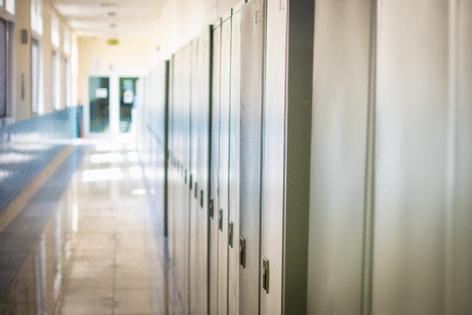Maryland struggles with student absences: 'We need to stop the bleeding'
Published in News & Features
BALTIMORE — State education leaders will start tracking student absences on a monthly basis, continuing their efforts to address the massive spike in absenteeism following COVID-19 school shutdowns.
“We need to stop the bleeding coming out of the pandemic,” Joshua Michael, president of the Maryland State Board of Education, said at a board meeting this week. “Every day matters for every kid.”
The Maryland State Board of Education aims to reduce chronic absenteeism — defined nationally as missing 10% or more of enrolled school days — by 15 percentage points over the next three years. Individual school districts, including Baltimore City, where nearly half of students are chronically absent, have also been working on improving attendance, with the City Council resolving to study the issue earlier this year. But in Maryland and across the country, there’s still a lot of work to do.
The rate of chronically absent students in Maryland was 19.5% in the 2018-19 academic year, prior to the outbreak of COVID-19 and subsequent school shutdowns. Chronic absenteeism shot up to 30% in the 2022-23 school year, and state leaders want to reduce it to 15% this school year. In the 2023-24 school year — the latest year for which data is available — the absenteeism rate was 26.7%.
The state’s highest rate of absenteeism is in Baltimore, where 49% of students were chronically absent in the 2023-24 school year, down from a pandemic high of 58%.
“We’re moving in the right direction,” said Baltimore City Council Member Mark Conway, who’s been taking the lead on absenteeism issues in the city. “But we’re still moving towards 50% of young people missing 10% or more of school. And that’s not where we should be.”
The state’s monthly tracking will allow absenteeism data to be released closer to real-time, rather than annually. The state board’s chronic absenteeism task force is also scheduled to deliver a report by Dec. 31, in addition to proposing any regulations on best practices to the state board.
Board members noted that a student’s attendance at school is directly related to their performance on assessments, and chronically absent students are 50% less likely to be proficient in English language arts.
Reducing absenteeism in Baltimore
Conway sponsored the City Council’s resolution earlier this year to study the causes and solutions surrounding student absences in Baltimore. Conway said he never received confirmation from the mayor’s office on whether the study would be funded. He said he believes the study would cost around $100,000, as there would be a need to gather information from visits to the homes of absent students.
A spokesperson for the mayor’s office said in an email that the ordinance requests the school system to prepare the report no later than 180 days after its passage in May of this year, and that there is “nothing that requires or expresses a need for the City to independently fund said study.”
Problems with transportation can be a major factor in kids not attending school. Conway believes the study would uncover other factors as well, including “unstable households, homelessness, changes of address,” as well as students not having enrichment opportunities at the beginning or end of the day that would motivate them to go to school.
Members of the City Council met in March to discuss absenteeism, and Conway said he suspects there will be more hearings, but none have been scheduled yet.
City Council Member Zac Blanchard noted the release of the Maryland Transit Administration’s “BMORE BUS” plan over the summer that would substantially improve the bus program in the city and create shorter gaps between bus arrivals. The problem is funding — estimated to cost around $1 billion.
“Figuring out how to fund BMORE BUS would be a huge benefit to getting our kids to school, along with a bunch of other things,” Blanchard said.
Conway noted that although the absenteeism dynamics in Baltimore are different from other parts of the state, that “doesn’t mean that they’re unsolvable.”
A spokesperson for the mayor’s office highlighted the mayor’s ongoing “attendance challenge,” recognizing individual school efforts on absenteeism. Earlier this week, the mayor visited James McHenry Elementary/Middle School, which saw a 23% reduction last year, the largest citywide.
Baltimore County saw greatest improvement
Baltimore County saw the greatest improvement on absenteeism of any county in the state in the past year, with 120 out of 176 schools having further reduced their chronic absenteeism rates, Superintendent Myriam Rogers said in June.
Prince George’s County Public Schools saw a 2.51% reduction in absenteeism over the last school year, bringing its absenteeism rate last year to 31.37%. The school system has a district-wide task force dedicated to solving the absenteeism problem and uses a SchoolMessenger system and pupil personnel workers to reach out to families, a spokesperson said. It also monitors data through central offices.
In Harford County, a pilot program to inform families about absences is expanding to all schools this year.
Howard County school staff “continually uplift the importance of cultivating these relationships and making individual outreach efforts at all times, but particularly when students are struggling to attend school consistently,” a spokesperson said in an email.
School systems in Anne Arundel County and Carroll County did not respond to a request for comment, and a Montgomery County Public Schools spokesperson said the district most likely could not provide information by The Sun’s deadline.
---------------
©2025 The Baltimore Sun. Visit at baltimoresun.com. Distributed by Tribune Content Agency, LLC.







Comments